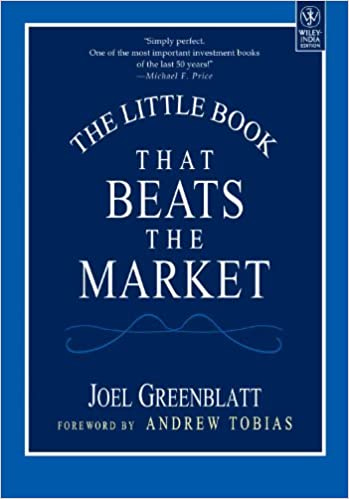Joel Greenblatt, a professor and value based investment manager, in his book ‘The Little Book That Beats The Market’ suggested a combination of the value and quality strategy to beat the market.

The formula was simple:
Establish a minimum market cap: say $50 million in their case. In India it would be 100 crores .
Exclude utility and financial stocks. Also in US, to exclude foreign companies or ADRs
Rank stocks based on ‘earnings yield’ i.e Earnings before interest and tax (EBIT)/ market cap + long term and short term debt (enterprise value)
Rank stocks based on ‘return on invested capital’ (ROIC) i.e EBIT/ Net working captial + Net fixed assets
Choose companies with highest combined rankings of earnings yield ranking and ROIC.
Invest equal-weighted in top 20 or 30 or 50 ranked companies based on the abvoe criteria
Rebalance yearly, preferably in June or July in India due to April-March financial year.
Be committed to see the strategy through for the long term and know there will be sharp drawdowns in between.
When Greenblat published his book in 2005, the strategy yielded 33% annual return from 1988 to 2004, outperforming the S&P 500 by 19%. However, since the publication of the book and popularity of the strategy due to its its simplicity, it’s lagged the index in the last 10 years by 4 odd %.
Indian Markets
Shyam has been running this strategy live since 2013, which is more reliable than a backtest.
Here is his performance


Over a 7 year period the strategy has done really well but has underperformed the large cap index during the 2-5 year timeline.
There’s a clear bias that the strategy does well in a bull market or where midcaps do well because the portfolio consists mostly of mid-caps and small caps.

Also the drawdown has been deep and long, imagine losing money for three years and losing as much as -67% at the trough. This strategy is not for everyone.
Limitations:
In a bull market, where market valuations are high, this strategy is highly vulnerable to picking lower quality companies and since it’s buy and hold extremely vulnerable to sharp drawdown when the market corrects from frothy valuations.
Non-frequent rebalancing means you could be stuck with holding a low quality portfolio for upto a year, prolonging the recovery compared to the index.
But if the strategy frequent rebalanced, it would sell the winners and stick to the losers which is not really a smart strategy according to us.
What should you do?
We think it makes sense to follow this strategy as part of a multi-strategy portfolio, if its one of the many strategies in a portfolio. This strategy can lend significant outperformance during a bull market but will struggle in a bear market.
Also as an option to diversify to midcaps and smallcaps via a value approach rather than a momentum can lead to some diversification benefits.
However, we strongly advice against investing solely into this strategy, unless you have the willingness and ability to bear the risk. And the patience to ride out the bad times that can last a few years.
Subscribe
If you are interested in this strategy you can implement it via our smallcase.

